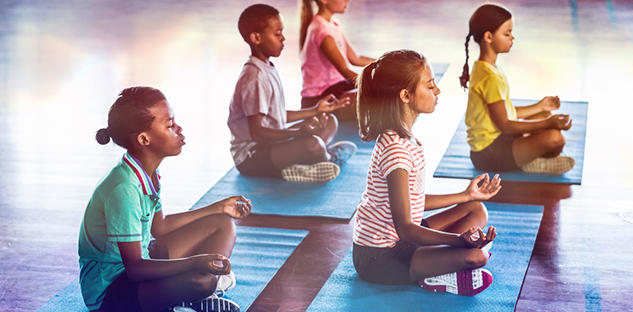
Yoga and Mindfulness in Your School Counseling Program
By Nick Abel, Ph.D., and Lade Akande | January 2022


 As most school counselors are aware, a significant number of youth in the U.S. face mental health challenges, and rates of diagnoses for disorders such as ADHD and anxiety have increased steadily for most of the 21st century. The ongoing pandemic is also negatively affecting student well-being for many reasons including frequent disruptions to school attendance, which is especially harmful to those with mental health issues because school-based services are the only form of treatment received by an estimated 35 percent of students in need.
As most school counselors are aware, a significant number of youth in the U.S. face mental health challenges, and rates of diagnoses for disorders such as ADHD and anxiety have increased steadily for most of the 21st century. The ongoing pandemic is also negatively affecting student well-being for many reasons including frequent disruptions to school attendance, which is especially harmful to those with mental health issues because school-based services are the only form of treatment received by an estimated 35 percent of students in need.It should be no surprise, then, that the ASCA position statement The School Counselor and Student Mental Health calls on school counselors to “recognize and respond to the need for mental health services that promote social/emotional wellness and development for all students.” Although school counselors use many interventions to answer this call, the practices of yoga and mindfulness are especially promising and worth considering as part of any comprehensive school counseling program. Past research has demonstrated that the use of yoga and/or mindfulness with children and adolescents has positive impacts on
In our current study with high school students, we have found that regular practice with yoga and mindfulness during the school day has significant impacts on student ratings of stress, anxiety, energy, readiness to learn, empowerment to face challenges, and other variables. In short, yoga and mindfulness seem to help kids – and with a little planning, you can be the one to introduce these practices to your students.
You don’t need special training, certifications, or a wealth of experience to bring yoga and mindfulness to your school. Resources are readily available both online and in print, and you might be surprised by the number of ways you can integrate yoga and mindfulness into a school via classes, partnerships with teachers, and Tier I and II counseling interventions like classroom instruction and groups. Below are a few tips for getting started.
- Identify student outcomes you would like to address through yoga and mindfulness. Are you seeing a rise in student anxiety? Has a student survey pinpointed stress reduction as a need? Comprehensive school counseling programs include goals based on demonstrated school needs and data tracked over time to demonstrate the impact of counseling interventions. Start with yoga and/or mindfulness by clearly identifying why you are doing it and how it will affect students.
- Create buy-in by teaching students and staff why yoga and mindfulness are helpful. Gather research, such as the links provided above, showing the effectiveness of these practices on anxiety, focus and stress. Share trends in neuroscience and adolescent brain development that further illuminate why yoga and mindfulness work.
- Start to educate yourself by searching for some simple yoga and mindfulness resources like the following:
- Yoga for Stress Management
- Teen Yoga Flow
- Kids Yoga Classes
- Yoga & Mindfulness in a Pandemic
- Mindfulness in Schools
- Meditation Instead of Detention
- Think about how you might fund the purchase of yoga mats, training materials and/or structured curricula that include mindfulness activities aligned with social/emotional learning competencies. Possibilities include simply asking your administrator or seeking small grants from the local PTO, area education agency, state department of education or state counseling association.
- Look for opportunities to integrate yoga and mindfulness into your school. Want to swing for the fences? Design a full semester class to be offered as a PE or health elective. Want to start small? Teach one classroom lesson on diaphragmatic breathing, progressive relaxation and/or simple yoga poses. Other options include partnering with an interested teacher to integrate yoga and mindfulness practice into an existing class; forming a club for students; visiting study halls to lead exercises or take volunteers outside or to the gym to do so; running a yoga and mindfulness group during lunch or an elective period; and leading the whole school in a few minutes of yoga and mindfulness at the beginning of the school day, during homeroom or advisory periods, or before school-wide exams. The options are endless, so be creative and do what feels realistic and likely to affect student outcomes.
- As you implement more yoga and mindfulness, consider seeking formal training and encourage other staff to do the same. As noted above, one does not need to be a certified yoga instructor, but it helps to get advice from experienced practitioners, learn from their experiences and practice a subset of techniques that are most applicable in the school setting.
Nick Abel, Ph.D., is an associate professor in the College of Education at Butler University in Indiana and Lade Akande is director of College Counseling at University High School of Indiana and an advanced physical education yoga and mindfulness instructor. Contact them at nabel@butler.edu and lakande@universityhighschool.org.